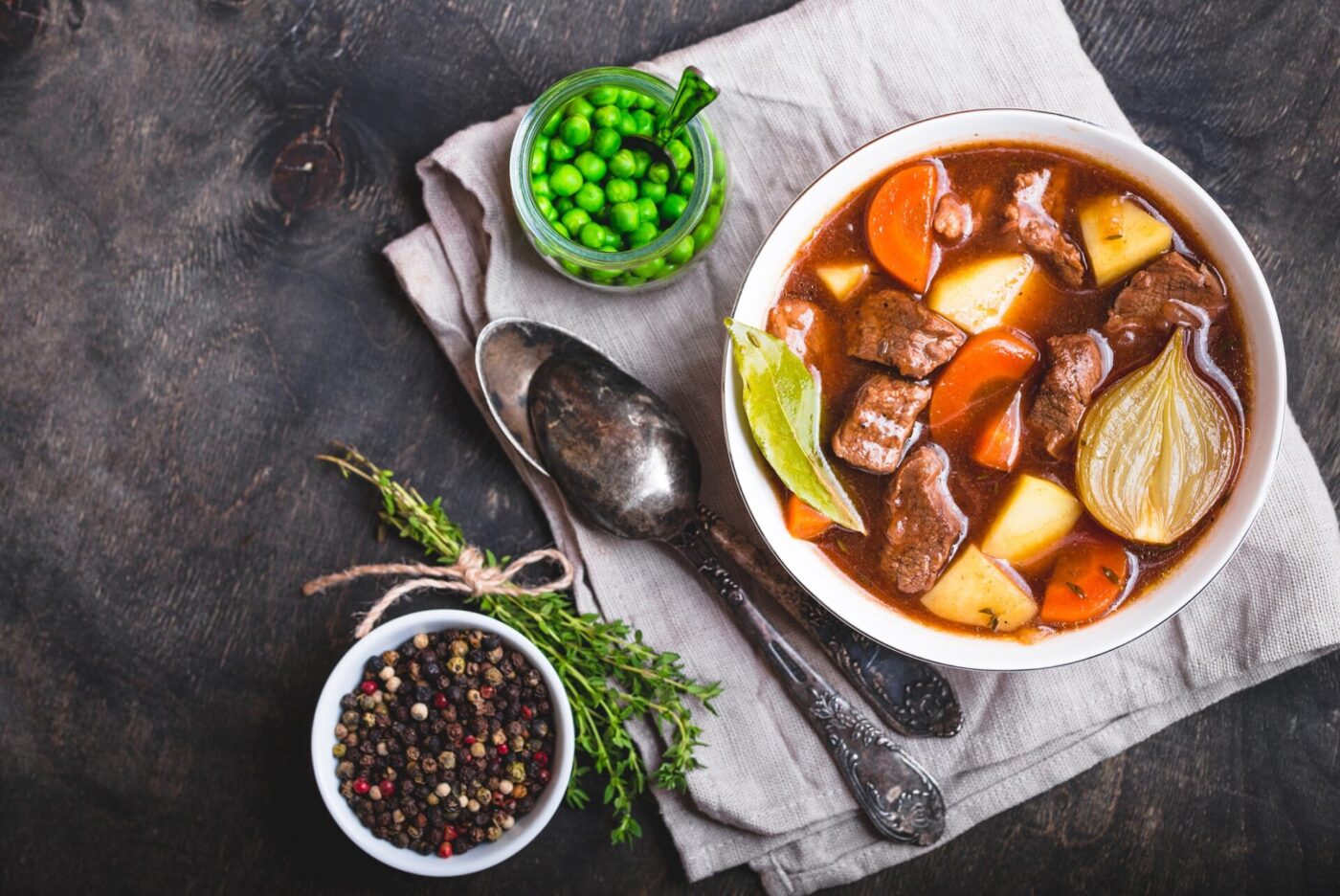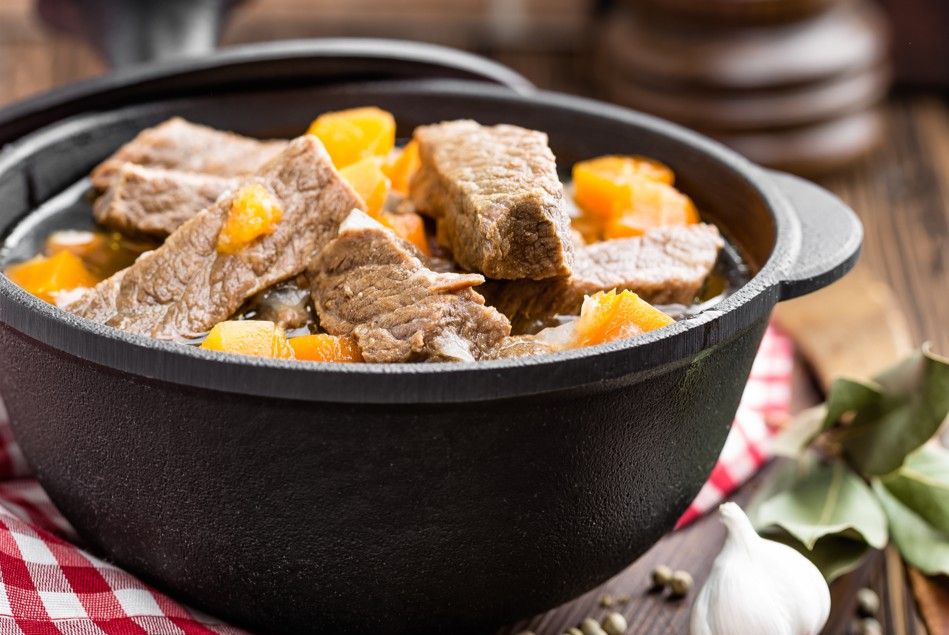Read More: Culinary History of Types of Beef Stew Meat
The Foundation: Tough Cuts and Slow Cooking
The core principle behind beef stew is the transformation of tough, less desirable cuts of meat into tender, flavorful morsels. This necessity arose from a time before refrigeration and selective breeding. Historically, cattle were primarily working animals, valued for their strength and ability to pull plows or carts. This meant their muscles were well-developed and, consequently, tough. Meat from older animals, past their prime working years, was also commonly used.
Early cooking methods, limited by technology, favored slow, moist-heat techniques. Stewing, braising, and pot-roasting were ideal for breaking down the tough connective tissues (collagen) in these cuts, rendering them palatable and releasing their rich, savory flavors. This approach also maximized the nutritional value of the entire animal, leaving nothing to waste – a crucial consideration in times of scarcity.
The Star Cuts: A Historical and Culinary Breakdown
Let’s explore some of the most popular beef stew cuts and their historical context:
Chuck: The Reigning Champion
- Origin: Chuck comes from the shoulder section of the cow, an area heavily involved in locomotion. This results in a cut with a significant amount of connective tissue and intramuscular fat (marbling).
- Historical Context: Historically, chuck was considered a “poor man’s cut” due to its toughness. However, its affordability and robust flavor made it a staple in working-class kitchens worldwide. In Medieval Europe, “pot-au-feu” (literally “pot on the fire”), a quintessential French beef stew, often utilized chuck or similar cuts. It represented a way to create a nourishing meal from inexpensive ingredients, slowly simmered for hours to extract maximum flavor and tenderness.
- Culinary Properties: Chuck’s high collagen content breaks down into gelatin during slow cooking, creating a rich, unctuous texture and mouthfeel. The marbling contributes to its deep beefy flavor. Different parts of the chuck offer varying textures:
- Chuck Eye Roast: More tender, suitable for quicker braises.
- Chuck Blade Roast: Very flavorful, but requires longer cooking.
- Chuck Shoulder (or Clod): Large and economical, ideal for large batches of stew.
- Modern Relevance: Remains the gold standard for beef stew due to its balance of flavor, texture, and affordability.
Round: Lean and Economical
- Origin: Round comes from the rear leg and rump of the cow, another area used extensively for movement. It is leaner than chuck, with less marbling.
- Historical Context: Similar to chuck, round was historically valued for its affordability and availability. It features prominently in many traditional stews across cultures, often paired with robust flavorings to compensate for its lower fat content. Think of the Italian “Spezzatino,” often made with lean cuts of beef like round, simmered in a tomato-based sauce.
- Culinary Properties: Round is less forgiving than chuck due to its lower fat content. Overcooking can easily lead to dry, tough meat. It’s crucial to use adequate liquid and a low cooking temperature.
- Top Round: The most tender part of the round, sometimes used for roast beef, but can also be used in stew.
- Bottom Round: Tougher and requires longer cooking times.
- Eye of Round: Lean and relatively tough, best suited for slow braising or stewing.
- Modern Relevance: Still a budget-friendly option, but requires careful cooking to achieve optimal tenderness. Often used in stews where a leaner result is desired.
Brisket: Slow-Cooked to Perfection
- Origin: Brisket comes from the breast section of the cow, beneath the chuck. It’s a large, tough cut with significant connective tissue and a layer of fat known as the “deckle.”
- Historical Context: Brisket’s toughness initially relegated it to lower-value applications. However, certain culinary traditions embraced its unique properties. Jewish cuisine, particularly Ashkenazi Jewish cooking, famously utilizes brisket in slow-cooked dishes like pot roast and, of course, brisket stew. The long, slow cooking process breaks down the tough muscle fibers, rendering the brisket incredibly tender and flavorful. In Texas, barbecue brisket became a culinary icon, smoked low and slow for many hours.
- Culinary Properties: Brisket is known for its rich, beefy flavor and distinctive texture. When properly cooked, it becomes incredibly tender, almost melting in your mouth. The fat cap (deckle) renders during cooking, basting the meat and contributing to its succulence.
- Modern Relevance: Brisket has enjoyed a surge in popularity, partly due to the rise of barbecue culture. While often associated with smoking, it remains an excellent choice for stews, particularly those with a smoky or bold flavor profile.
Short Ribs: The Ultimate Indulgence
- Origin: Short ribs come from the rib section of the cow, specifically the shorter, meatier portions. They contain a significant amount of bone, meat, and fat.
- Historical Context: Short ribs were traditionally a by-product of butchering, often considered a less desirable cut. However, Asian cuisines, particularly Korean and Chinese, have long embraced short ribs, using them in braised and stewed dishes. “Galbi jjim” (Korean braised short ribs) is a prime example.
- Culinary Properties: Short ribs are exceptionally flavorful, with a rich, decadent texture. The bone marrow contributes to the richness of the stew, while the marbling ensures tenderness. The collagen breaks down during slow cooking, creating a luscious, sticky sauce.
- Modern Relevance: Short ribs have become a gourmet ingredient, prized for their intense flavor and luxurious texture. They are often featured in upscale restaurant menus and are a popular choice for special occasion stews.
Oxtail: A Gelatinous Gem
- Origin: As the name suggests, oxtail comes from the tail of the cow. It consists of bony segments surrounded by meat, fat, and a high concentration of collagen.
- Historical Context: Oxtail was once considered a waste product, often discarded or used for making stock. However, frugal cooks in many cultures recognized its potential. In the Caribbean, oxtail stew is a beloved dish, often cooked with beans and spices. In British cuisine, oxtail soup has a long and storied history.
- Culinary Properties: Oxtail is incredibly rich in collagen, resulting in a remarkably gelatinous and flavorful stew. The meat, once cooked, is incredibly tender and falls off the bone. The bone marrow adds further depth and richness.
- Modern Relevance: Oxtail has gained recognition as a delicacy, prized for its unique texture and intense flavor. It’s often featured in traditional and contemporary stews and braises.
Beyond the Traditional: Other Stewing Meats
While the above cuts are the most common, many other parts of the cow can be used for stew, reflecting regional variations and specific culinary traditions. These include:
- Shank: From the leg, very tough but flavorful, often used in osso buco.
- Neck: Bony and flavorful, requires long cooking times.
- Cheeks: A delicacy, incredibly tender and rich after slow cooking.
- Heart: Though technically an organ meat, beef heart can be stewed, offering a unique, slightly gamey flavor.
The Evolution of Stew Meat: A Culinary Mirror
The history of beef stew meat is a reflection of broader societal and culinary trends. As butchering techniques evolved, and refrigeration became widespread, access to different cuts of meat increased. The rise of industrial agriculture led to cattle breeds specifically developed for meat production, resulting in more tender and flavorful animals.
However, the core principles of stewing – slow cooking tough cuts to achieve tenderness and flavor – remain timeless. Whether using traditional chuck or exploring the rich flavors of oxtail, understanding the history and properties of different beef stew meats allows us to appreciate the ingenuity of past cooks and create truly delicious and satisfying meals. The story of stew meat is, in essence, a story of resourcefulness, adaptation, and the enduring power of simple, slow-cooked food.



Comments